| Home > Policy > White Paper, Notice, Announcement > White Paper > Japanese Government Policies in Education, Culture, Sports, Science and Technology 2002 >Chapter3 Section3.2 | ||
In compliance with the concept of the Courses of Study and the comprehensive five-day school week, schools set about various active measures. Such measures include the promotion of moral education which appeals to the spirit and the mind of children, the development of different hands-on activities in schools, the enhancement of reading activities, and the improvement of the educational guidance system to deal with children's problematic actions, etc.
(1)
Promotion of Moral Education
| 1) Significance and characterization of Moral Education in school education |
| (a) Significance of Moral Education |
Moral education is to enable each student to take a good look at him/her self and his or her future. It is also to assist a student to acquire the morality necessary to become a good member of society.
At schools, education is conducted with the aim of cultivating well-coordinated human beings. Moral education is designed, through various activities, to nurture the moral sense rooted in children's inner nature.
| (b) Characterization of Moral Education |
Moral education is basically carried out through the overall educational activities in schools.
In elementary and lower secondary schools, while maintaining a close coordination between all other educational activities and moral education, "moral studies" (one unit hour/week, 35 unit hours/year) is set up in order to complement, to deepen and to integrate such activities. This class is the pillar of moral education, and is taught by homeroom teachers to help each student to cultivate his/her thoughts while reflecting on him/her self.
In upper secondary schools, special hours are not specially provided for moral studies; however, moral education is incorporated in overall educational subjects; mostly in civics or special homeroom activities. Guidance and assistance are provided to students so that they are able to seek their own way of life and to find meaning in life.
| (c) Substance of Moral Education |
The substance of moral education provided to children is described in the Courses of Studies for elementary and lower secondary schools. They are classified and arranged into four categories based on the following viewpoints:
| (d) Points for promotion of Moral Education stated in the new Courses of Study |
According to the report of the Curriculum Council (July 1999), three basic policies for the promotion of moral education are listed as follows.
Based on these points in the new Course of Study, efforts have been made to improve the following aspects: to develop the ability to tell right from wrong, to love one's own land, to develop attractive educational materials utilizing various hands-on activities, etc., to make an effort to improve the guidance focusing on the actual conditions of children and schools, to seek active participation and cooperation of local citizens in moral education at schools.
|
The Ministry of Education (then) conducted a survey on efforts to promote moral education covering national, public and private elementary and lower secondary schools, municipal governments and local boards of education across the country. While efforts yielded some achievements, certain points were found to be in need of further improvements.
- The average unit hours in a year of moral studies in the country are 33.9 hours for elementary schools and 31.0 hours for lower secondary schools. Both figures show an increase from the previous year. However, there are still many schools with less than the 35 unit hours / year that are set as standard hours as stated in the Courses of Study.
- Among course items concerning achievement level of moral education, the items with which more than 50% of schools answered "mostly satisfied", are only "to love nature and animals", "to be lively and to be honest" in elementary schools, and "to exercise moderation in life" for lower secondary schools. There were no other items with which more than 50% of schools answered "mostly satisfied". |
| 2) Efforts made for the promotion of Moral Education. |
The Ministry of Education, Culture, Sports, Science and Technology has made efforts to improve moral education by providing various measures. Major activities are listed below.
| (a) Creation and distribution of "kokoro no note" (notebooks for moral education) |
"kokoro no note" is a study material in which desirable morality for children is clearly and understandably described and explained. This can be used as an aid to help children think and learn of their own volition. (There are four kinds: one for 1st graders, one for 2nd and 3rd graders, one for 5th and 6th graders, and one for lower secondary schools). The leaflets were distributed to every school in the country in 2002.
"kokoro no note" can also be used in a variety of actual situations of daily life. It can be used for many other subjects than "moral studies". Children can open the page freely and write in anything. The topic can be easily brought up at homes. Through creative use of "kokoro no note" both at schools and at homes, it is expected that children broaden the understanding of morality and become aware of their own development in morality by actively participating in the morality classes. The note is also expected to play an important role to enhance the moral education through hands-on activities. It will also be used for the formation of a better guidance system by the common understanding among teachers involved. It will play the role of a bridge between schools and homes for the promotion of their cooperation.
In order to promote the further use of "kokoro no note", the Ministry of Education, Culture, Sports, Science and Technology has distributed manuals for teachers of elementary and lower secondary schools. In the future, The Ministry plans to provide leaflets of examples of the practical use of "kokoro no note" in various places and situations.

| (b) Promotional activities for Moral Education which appeal to children and students |
In compliance with the actual state of local communities and schools, practical research activities in cooperation and coordination with prefectural boards of education have been implemented in order to promote moral education designed with ingenuity and creativity to attract children. These activities are the provision of moral education utilizing local manpower and hands-on activities, the traditional cultural education, the development of materials for moral education, and moral education at upper secondary schools.
| (c) "Kokoro no Sensei" (Teachers for children's minds) |
Since 2001 talented personnel have been employed from outside of the schools as special part-time teachers in "the Project for Mutual Exchange between Schools and Society". Since the FY 2002, various human resources have been tapped to promote moral education that appeals to children. Versatile people in the local area or people with specialties were provided to schools as "Kokoro no Sensei". (1,121 people were provided in the FY 2001) Even prior to the start of the program, we had witnessed some examples of improvements of moral education by the participation of local citizens and parents. So, successful results are greatly expected. Since these classes are held involving a lot of local residents, this program is expected to contribute to the open school systems as well.
| 3) Emotional education from early childhood |
In view of the importance of early childhood education as a period of basic character building, practical research is under way to improve an awakening of morals, along with making their development one of the important goals for kindergarten education. In FY 2001, the Collection of Case Studies on Cultivating the Awakening of Morals in Kindergarten Children was given to all kindergartens as a reference for teachers in guiding children. In FY 2002, "Campaigns for Cultivation of Mind of Children" started in order to cultivate "Richness in Mind" of children by inviting the participation of the whole society. (Website of the Ministry of Education, Culture, Sports, Science and Technology: https://www.mext.go.jp/a_menu/shotou/youji/index.htm)
| 1) Significance and effect of hands-on activities |
It is important for schools, homes, and communities to each function fully to increase places and opportunities where children gain real experience in nature and society so that they can develop their own desirable character traits and enrich social skills. With amendments of both the School Education Law and the Social Education Law in July 2001, the following items were stipulated in the laws: (1)While maintaining close coordination with organizations related to social education, schools should attempt to improve hands-on activities such as volunteer activities, community service, and hands-on activities in nature. (2) The boards of education should implement various programs and projects regarding provision of these various hands-on opportunities.
In the report of Central Council for Education issued on July 2002, titled "Promotional measures for Social-work Activities and Hands-on Activities for Young People", further development of the social framework with cooperation and coordination among schools, homes, and local communities is recommended. The aim of the framework described in the report is to create a society in which every member of society support each other. It is also mentioned that, when young, it is necessary to offer the opportunity to participate in various activities such as community services and hands-on activities in and out of schools in order to nurture "Rich Humanity".
The provision of hands-on activities is expected to have various other effects on children, in addition to cultivating "Rich Humanity" and social skills.
For example, according to the studies conducted by the National Institute for Educational Policy Research, the percentage of children who are willing to study "much harder", and "harder" after having hands-on activities in a natural environment is 91.4% among elementary school students, 73.2% among lower secondary school students, and 62.9% for upper secondary school students. Moreover, after having contact with local people, the rate is 86.8% for elementary and 60.9% for lower secondary, and 51.3% for upper secondary. It is now clear that hands-on activities increase the students' incentives to study. (See Table 1-3-7 )
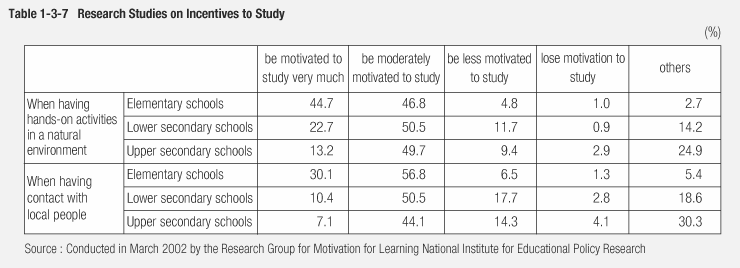
| 2) Improvement of hands-on activities in school education |
The Ministry of Education, Culture, Sports, Science and Technology issued the "Collection of Cases of Hands-on Activities at School", based on the advanced examples of hands-on activities conducted by elementary, lower secondary, and upper secondary schools, and distributed them to boards of educations, etc.
Also, in FY 2002, "Rich Experience Activity Model Program" was newly launched. "Rich Experience Promotion Area" and "promotional schools" were designated in each prefecture, and the promotions in these areas and schools are expected to be models for other schools (100 areas and 800 schools were designated in FY 2002.) The aim of this project is to enrich hands-on activities in every elementary and lower and upper secondary school through the spread and the introduction of model activities, approaches and efforts conducted by the designated "areas" and "schools" for promotion. Booklets of collected examples of cases of activities will be issued and conferences on these hands-on activities will be held to make the most of these promotional projects.
In addition, the local municipal governments are supporting activities for the hands-on activities in schools: for example, a "Trial Week" project in Hyogo Prefecture, or an "Exciting Work Experience" project in Ishikawa prefecture. It is expected these valuable activities will spread widely.
| 3) Other efforts to improve hands-on activities |
| (a) In-service training of teachers for hands-on activities |
It is necessary to increase and develop the knowledge and experience of teachers about hands-on activities in order to promote hands-on activities. It is also beneficial for teachers themselves to undergo various social activities at private companies or public facilities. Boards of education of prefectures have introduced long-term social hands-on training programs in which teachers are sent to other institutions from one month to one year. In FY 2000, a total of 1,042 teachers were sent to organizations other than schools, such as private companies, welfare organizations, or social education organizations.
| (b) Credit accreditation of volunteer activities in upper secondary schools |
With the amendment of the ministerial ordinance in 1998, it is now possible for upper secondary schools to use their own discretion to give students credits for certain activities by recognizing them as a part of the curriculum. Such activities are volunteer activities, internships , and other related activities. In the fiscal year 2001, 131 upper secondary schools in 33 prefectures gave students credits for volunteer activities and other related activities.
| (c) Promotion of on-the-job experience / internship, etc. |
On-the-job trainings or internships for upper secondary school students are regarded as being of high educational values and effectiveness. Through working experience in the areas related to the future course of their academic or professional careers, students are expected to acquire a desirable view of career and work, to deepen understanding the relationships between learning and working, and to improve their communication skills through contacts with adults other than teachers or parents. The number of high-schools implementing internships is increasing every year, and in FY 2001, 38.9% of the total public (full-time) upper secondary schools. (21.7% for regular course, 67.8% for vocational course, and 69.1% for comprehensive course) conducted internship programs.
The new Course of Study for Upper Secondary Schools stipulates the provision of more opportunities for on-the-job training in upper secondary schools.The Ministry of Education, Culture, Sports, Science and Technology, in order to support and promote these efforts, distributed notice to prefectural boards of education to ask for the promotion of internship, and to relevant economic organizations to request the positive acceptance of the interns.
The Ministry is making efforts to hold nationwide forums for the promotion of internships and to create internship leaflets of collection of internship cases.
The Ministry considers systematic career education in accordance with the development of students important (to help students gain a desirable view of profession and labor, to acquire necessary skills and knowledge for work, to understand the individual characteristics, and to foster ability and capacity to select vocation of their own volition). In order to discuss how the ideal career education should be and the ways of promotion of career education, "Consultative Council for Comprehensive Research and Study on the Promotion of Career Education", consisting of specialists from various areas such as education, economy, labor, and administration, was just established in November 2002.
|
All the 2nd graders in the public upper secondary schools in the prefecture, all the 2nd graders of prefectural schools for the blind, schools for the deaf and schools for the disabled participate in vocational hands-on activities for 3 days. Teachers, parents and members of local enterprises and other facilities comprise a promotional committee for this program, and they all work in a coordinated manner to prepare and manage the activities. It is a good opportunity for students to gain a desirable view of career and work through contemplating their own future course and profession. At the same time, through a valuable experience of actual life in society, they learn practical matters such as consideration for others, proper greeting manners and courtesies and being responsible. 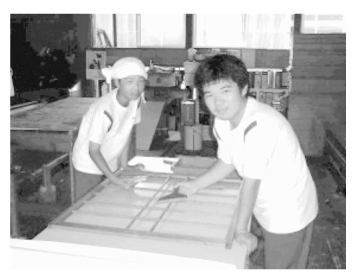 |
|
Utilizing the facility of the Kami-mihara Elementary School which closed in 1995, Wada-machi in Chiba Prefecture opened "A Lodge in Nature/Kusu no Ki" in September 1997. This facility is the place to meet and get to know others, especially for those from big cities to meet and interact with local residents. In "Kusu no Ki", classrooms were renovated into lodging facilities and kitchens, and special equipment for making Natto,(fermented soy beans) and soy bean paste was installed. During summer vacations, many children's groups and families visit the facility from the prefecture as well as from neighboring prefectures in the Kanto region. 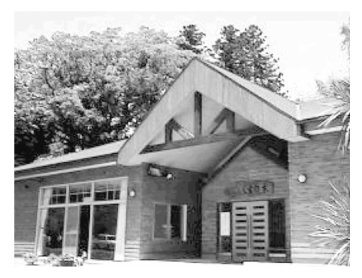 |
| (d) Open school facilities, etc |
From the view of conducting hands-on activities in and out of schools, it is important to open the school facilities to the local residents after school or on weekends. The Ministry of Education, Culture, Sports, Science and Technology encourages the local bodies to open school facilities to the local residents or to use closed school facilities for social education.
Reading is an effective activity to cultivate sound and rich sensibility and a feeling heart in children. In the Courses of Study, the aim of the study of Japanese language is to foster a positive attitude toward reading, to encourage reading widely, and to encourage students to broaden their horizon through reading.
The study conducted by a private organization in May 2002 shows that the average volume of books children read in a month was 7.5 books for elementary students, 2.5 books for lower secondary, and 1.5 for upper. The ratio of students who did not read a book at all during the month was 8.9% for elementary, 32.8% for lower secondary, and 56.0% for upper. (See Figure 1-3-9 )
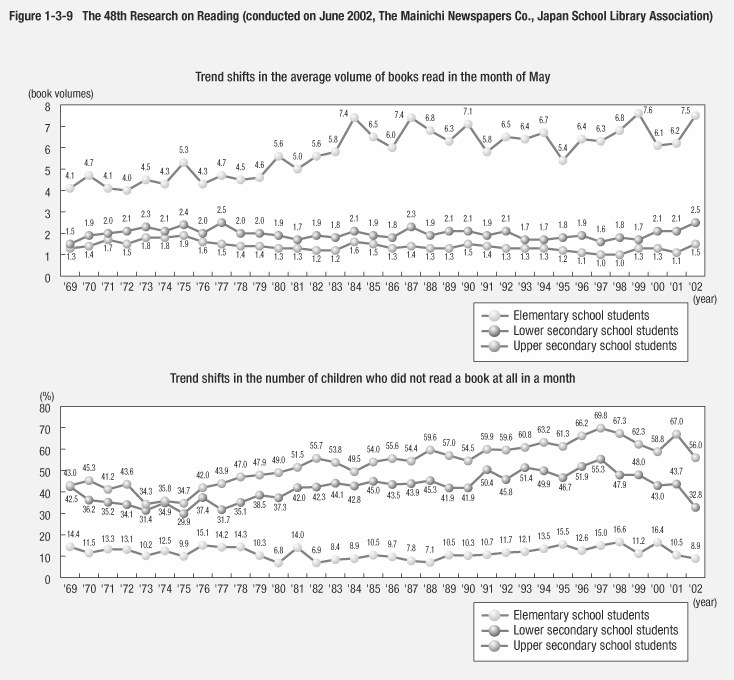
To improve the situation, The Law for the Promotion of Children's Reading Activities was issued and enforced in December 2001 in order to improve the environment so that children are willing to read anytime and anywhere. "Basic Plan for the Promotion of Children's Reading Activities" were formulated based on the law in August 2002. Various measures are suggested in the plans to promote reading activities as well as to establish the reading habit. Measures include activities like "morning reading time", reading sessions to children, and the enrichment of school libraries.
|
The Minami lower secondary school of Shiraoka cho, Saitama Prefecture introduced "Collective Morning Reading" in FY 1998. For 10 minutes every morning, except Tuesdays when a morning assembly is held, all the students read books. Through such activity, the aim is to increase an interest in books among children as well as to learn the importance of life and to cultivate the judgment of right to wrong, and to acquire a feeling heart and an active mind. Children say "I have one more reason to come to school," "It feels nice to have a quiet time in the morning," "I became interested in many things." 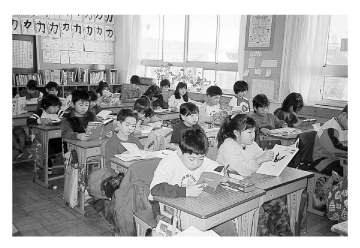 |
| 1) To cultivate respect for human rights |
Observing the heart of the Constitution and the Fundamental Law of Education, it is vital to promote education for basic human rights. Through classes like social studies, civics and moral studies, students are encouraged to have mutual respect, to care for others and to be responsible for the creation of a society without discrimination or prejudice. According to the stage of development of each child, different efforts are made to increase overall awareness of respect for individual rights and human dignity through comprehensive educational activities. A cabinet decision was made on the "Fundamental Plans for human right education and its enlightenment" on March 2002. The Ministry of Education, Culture, Sports, Science and Technology conducts practical researches at designated schools and communities as a model case, and it makes an effort to promote a comprehensive approach toward the improvement of the human right education.
| 2) To cultivate a mind that cherishes and values nature and culture |
An important element of "Rich Humanity" is to cherish and value nature, which is nurtured through deeper understanding of nature and culture. Within the scope of the school environment, each school makes an effort to provide hands-on activities in nature in special class activities or comprehensive studies. Also, in classes like science or in life environmental studies, children are given a chance to foster animals or grow plants so as to broaden the scope of their understanding of nature as well as to cultivate a mind that cherishes and values nature. In addition to that, environmental studies are carried out to bring about a desirable attitude toward the preservation of nature and building a better environment in social science or home economics classes.
Also, social science projects are assigned for research on local traditions and cultural artifacts, traditional annual events, or on the achievement of those who have come before us. In music and arts lessons, students have a chance to learn about traditional music and art pieces. Whenever or wherever possible, students are exposed to the local culture and traditions in the comprehensive lesson periods. Through such activities, children learn to value and cherish local and Japanese culture, traditions, and history.
| 3) Establishment of human relations through special activities |
Special activities consist of homeroom activities, student board activities, and various school events, etc. For example, objectives of the special activities in lower secondary schools are "to develop a well balanced mind and body, to cultivate the positive and practical attitude to build a better society as a member of collective society, to develop deeper awareness of a way of life as an individual and to develop the skills and abilities to make the most of oneself."
In accordance with these goals, education through special activities as group activities is carried out so that students are more aware of their roles as members of society and thereby social skills and "Rich Humanity" are cultivated.
In the new Courses of Study, some improvements are made on the special activities. The improvements are to emphasize the following aspects: to produce desirable human relations, to acquire basic morals and social rules, to cultivate the positive and practical willingness to build a better society in cooperation with others, and to improve the educational functions of guidance. It is expected that each school, with its own ingenuous creativity will make efforts to improve natural and social hands-on activities and to provide proper guidance to encourage students to be involved actively and practically in various activities. At the same time attention will be paid to the individual student's needs and the stage of development. Schools are also expected to advise students to cooperate well with other people at home and in the community, to make use of social educational facilities and to make contact with pre-school children, senior citizens, or handicapped persons.
It is important for homes, schools and social communities to play distinctive roles in their own areas while keeping close contact with each other in order to solve students' undesirable behavior such as serious violent actions, bullying or non-attendance at school. Schools are required to establish a comprehensive guidance system for students under the leadership of the principals while making more efforts to understand students so that each and every student is able to lead an enjoyable and lively school life.
With that idea in mind, the Ministry of Education, Culture, Sports, Science and Technology has implemented the following comprehensive measures. Also, the Student Guidance Research Center of the National Institute for Educational Policy Research has conducted some research and study activities that contribute to the planning and designing of administrative policies for student and career guidance.
| 1) Making classes easy to understand, making the school a pleasant place, and improving the "Emotional Education" |
Schools must be a place for children to enjoy learning and to act dynamically. Each child must be treated with respect so that he/she is able to feel the joy of self-existence and self-realization. Bearing in mind that the underlying role of education is to contribute to the character building of each student while respecting them, schools are required to steadily implement the ideas stated in the new Courses of Study.
The Ministry of Education, Culture, Sports, Science and Technology is taking measures other than the ones stated in this section, covering wide areas of education aimed at improvement of student's academic achievement. (See Chapter 2 )
| 2) Improving the quality of teachers |
It is important for all teachers to have proper knowledge and awareness of the undesirable behavior of children and to be capable of providing proper guidance to prevent or detect such tendencies early and to solve the problems fast. Comprehensive trainings were introduced for teachers to gain comprehensive and practical skills and knowledge on theories and practices on student guidance and educational counseling. In addition, special training sessions for new and experienced teachers are provided by prefectural boards of education.
| 3) Improvement of educational counseling system |
It is important to improve the educational counseling system at various administrative levels involving schools, towns and villages, and prefectures in order to cope with anxieties or worries about school education which children, students, parents and teachers have.
The ministry has allocated clinical psychologists as school counselors who are the "specialists on mind and emotion" to enhance the function of the educational counseling system of schools since FY 1995. Since FY 2001, the Ministry has provided subsidies for the necessary costs for researches and studies on issues involving the use of counselors in prefectures and designated cities. (5,500 schools in FY 2002). Through the efforts to-date, many reports have been submitted suggesting that the allocation of school counselors are quite effective in two ways: one is to prevent, discover, and solve undesirable behavior of children and students, and the other is to give appropriate advice to parents and teachers on how to communicate with children.
Former teachers or leaders of youth groups among local members have been allocated as "advisors in the classrooms for easing children's mind" since 1998, and they lend an ear to children's worries in a friendly and comfortable manner so that students can feel at ease and do not have to keep troubles to themselves. (4,000 schools in FY 2002)
| 4) Cooperation among schools, homes, communities and relevant organizations |
Solutions to undesirable behavior of children and students require a joint effort of schools, homes, communities and relevant organizations. The report of the "Consultative Council for Research and Survey on Undesirable Behavior of Children" conducted by the Ministry of Education, Culture, Sports, Science and Technology and issued on April, 2001 proposes that what is needed is more than just an exchange of information between schools and relevant organizations ("cooperation in information"); rather, all parties must concentrate their joint efforts while playing their own roles properly and adequately ("cooperation in action"). In response to this report, the ministry has implemented the ??Community Assistance System Promotion Program including 'Support Team'" since FY 2002. The projects are to organize the support teams in the local communities (a support team deals with the needs of troubled children or students with cooperation between schools, board of education and relevant organizations). (Applied to 100 local areas in FY 2002)
| 5) Making school a safe place and improving the school suspension system |
In consideration to serious concerns over bullying, in several cases students committed suicide, the Council on this issue with specialists in this field have proposed several recommendations, on which the Ministry has taken prompt actions against bullying in schools while keeping close relations with boards of education and other relevant organizations. Based on the understanding that to bully those who are weaker or smaller should never be tolerated in society, the Ministry places a special emphasis on the provision of empathic guidance from the standpoint of the bullied children.
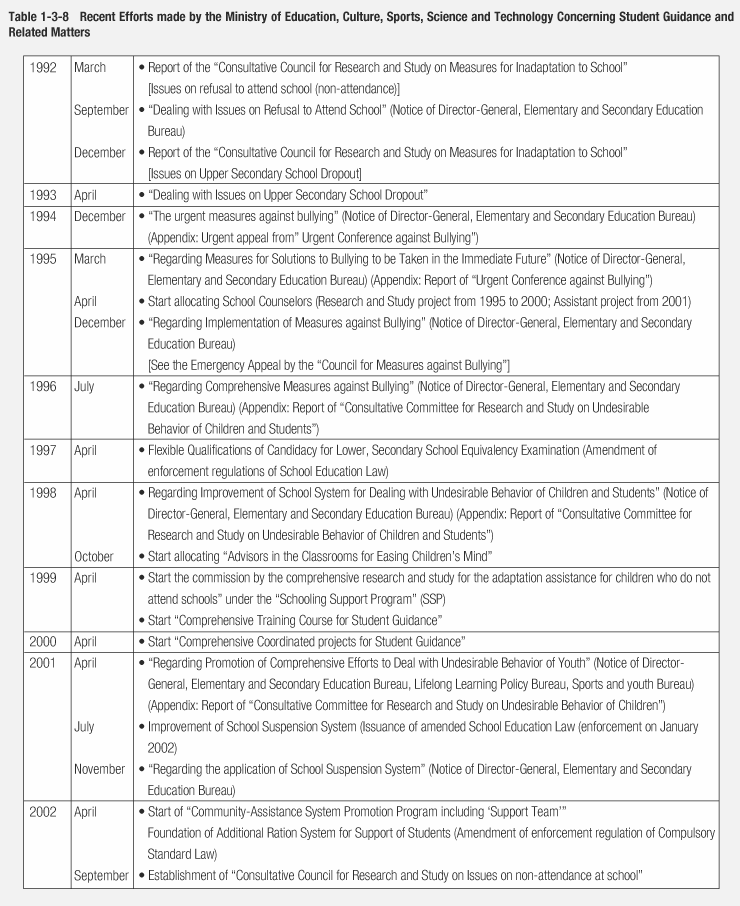
As for the school suspension system of public elementary schools and lower secondary schools, the report of the National Forum of Educational Reform recommended "to be clear in the treatment of children who cause trouble at school" in order to make school a safe place to go to. Based on the recommendation, the School Education Law was amended on July 2001 and some improvements were made on the school suspension system: (1) clarification of requirements, (2) improvement of procedures, and (3)measures for provision of lessons during the suspension period. (Enforced on January, 2002) The Ministry is providing guidance and support to local boards of education so they can operate the suspension system appropriately.
| 6) Flexibility in dealing with children who do not attend schools |
It is important to deal with children who do not attend schools with the assumption that it can happen to any child. The Ministry suggests that a school should be an "emotional resting place" for children, and it gives guidance for the effort to be made by the school. Flexibility has been applied to administrative matters. For example, when a student attends the adaptation assistance classes, it is counted as school attendance. Flexibility is given to the qualifications of candidacy for Lower Secondary School Equivalency Examination. The commission of the comprehensive research and study for the adaptation assistance for children who do not attend schools under the Schooling Support Program (SSP) was implemented in FY 1999. (Applied to 635 institutions in FY 2002)
On September 2002, the Consultative Council for Research and Study on Issues on Non-Attendance at School started, discussing what measures for children who do not attend schools should be implemented.
Exposure to violent and sexual materials in the media is considered to be harmful for young people, who are still in the process of physical and mental development, and therefore not yet fully mature in terms of sense of judgment and responsibility. The Japanese government, especially the Cabinet Office, has tackled this issue. Serious concerns have risen in recent years over the cases where children get involved in crimes through the use of the Internet.
The Ministry of Education, Culture, Sports, Science and Technology promotes the development of the practical ability for children to utilize available data and information and attain the scientific understanding of information, as well as to make them understand the roles and influence of the information and information technology on our daily life. In other words it is to foster the "competence to utilize information properly and effectively" so as to respond well to the rapidly developing information society. Specific measures are described in the new Courses of Study. One of them is to become used to computers and IT networking systems and to be able to utilize them properly for various subjects. Another is to introduce the effects and influence of information on society in classes like technology and home-economics in lower secondary schools so that students are able to grasp the idea of information morality. Students will be trained to take the individual responsibilities and issues associated with collection and transmission of information in IT classes of upper secondary schools. Moreover, in order to support the efforts made by each school, the guidelines are created and distributed to explain the assistance and methods of information morality education for children and students.
| Back To Top | MEXT HOME |